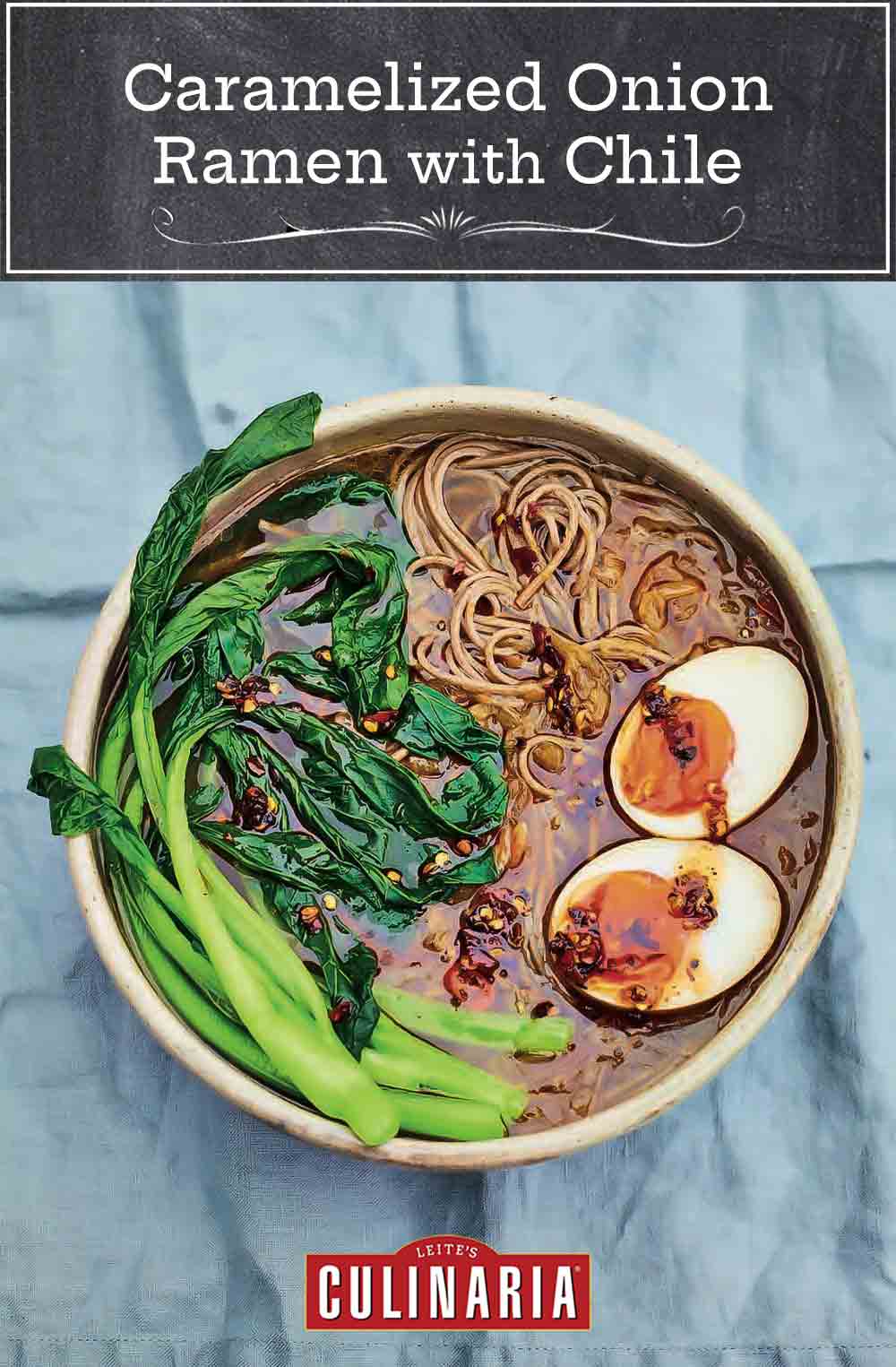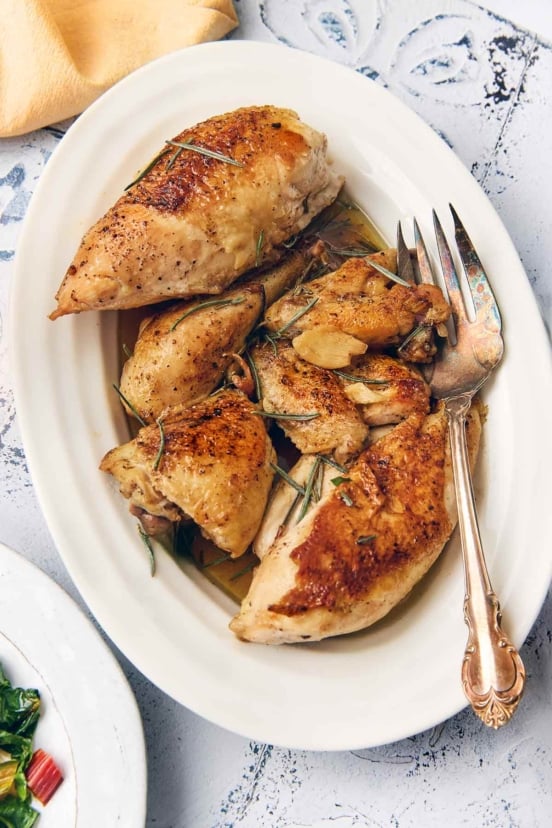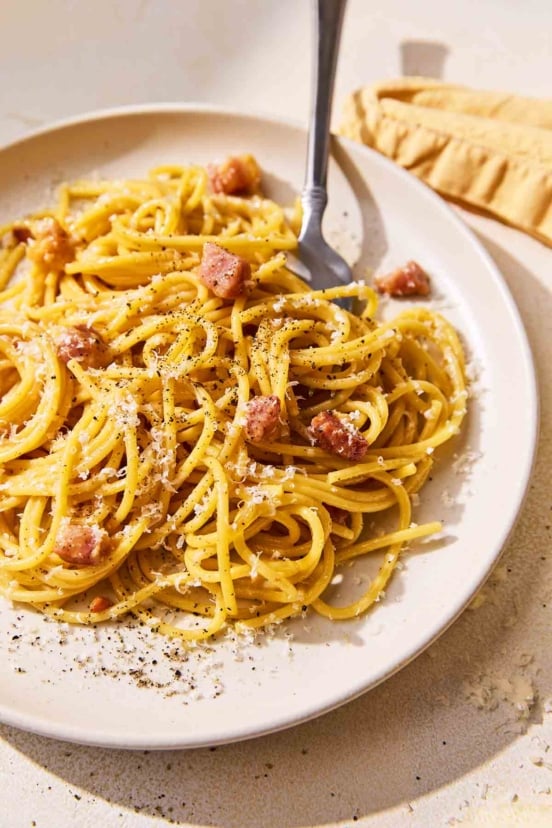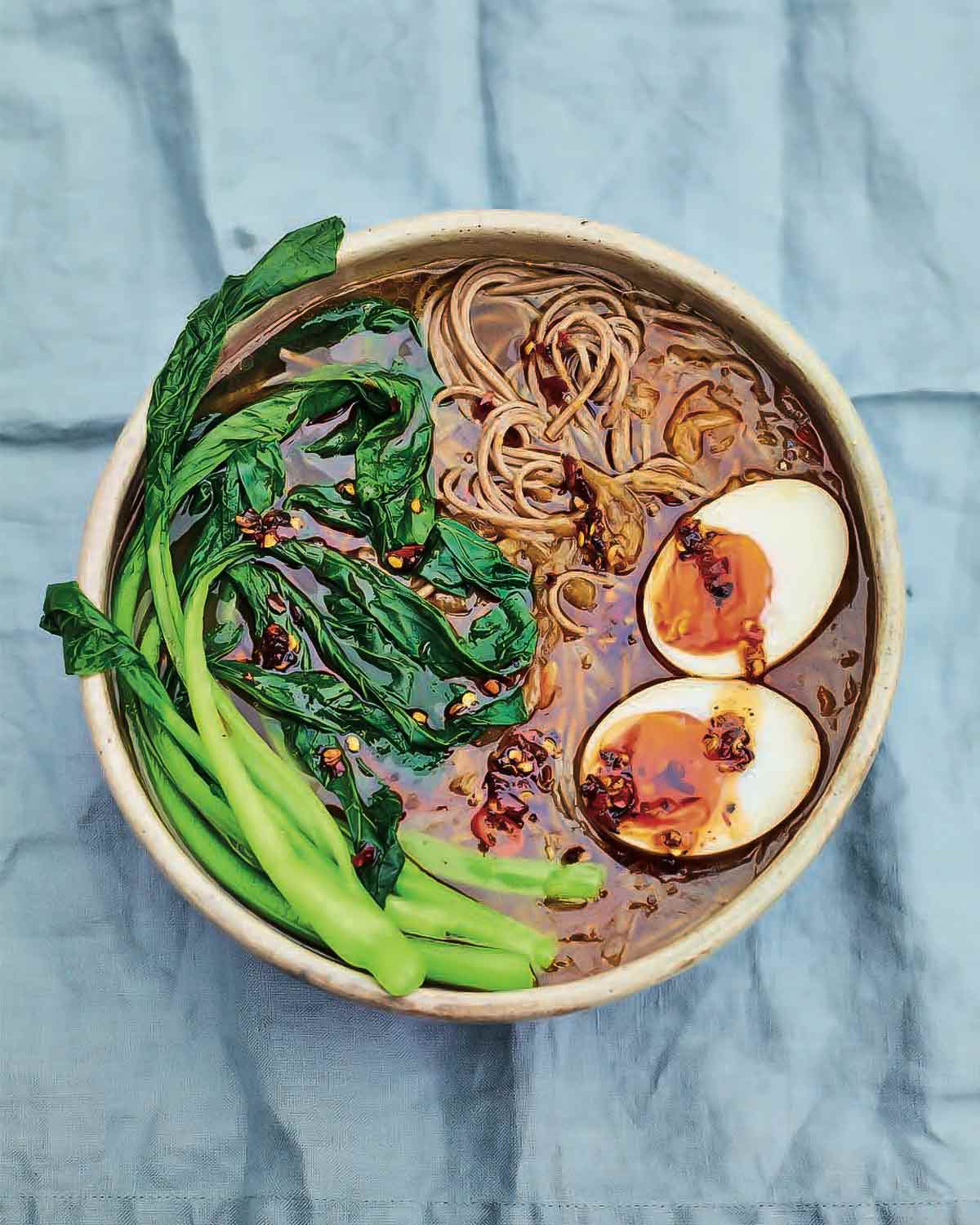
From the outside, Japanese food can seem rigid, steeped in centuries of tradition. But the truth is that it is a story of continual innovation. Ramen, for example, is an adaptation of Chinese wheat noodles and was first introduced to Japan by Chinese immigrants in the early twentieth century. And although there is only one name to describe this soupy noodle dish, there are as many variations of ramen as there are cooks in Japan. My recipe evolved from an unlikely place, taking inspiration from a French onion soup I ate in a cafe in Paris. In my recipe, sticky onions combine with miso, stock, and sake to make a very special-tasting soup.–Meera Sodha
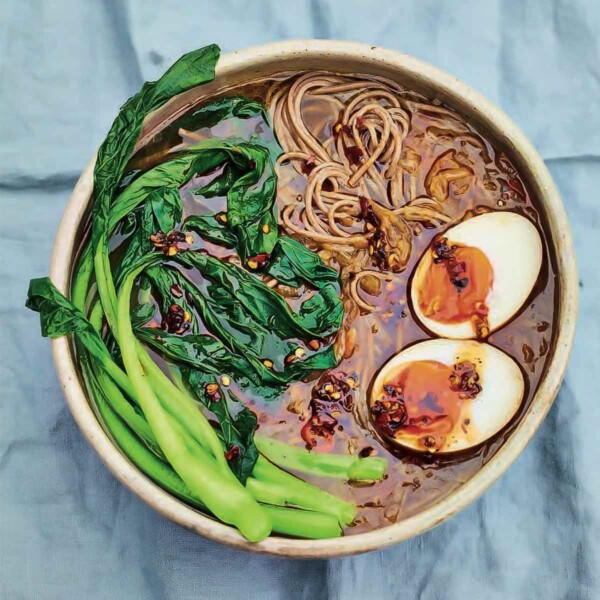
Caramelized Onion Ramen with Chile
Ingredients
- Mild vegetable oil
- 1 large onion (8 oz | 227 g), finely sliced
- 3 cloves of garlic, finely sliced
- 1/2 teaspoon kosher salt
- 1 fresh bird’s-eye chile, finely sliced
- 6 1/2 cups store-bought or homemade vegetable stock
- 2 tablespoons sake, rice wine, or dry sherry
- 1 1/2 tablespoons soy sauce or tamari
- 1 tablespoon brown rice miso*
- 7 ounces ramen noodles
- 1/2 pound choy sum, cut into 2 1/2-inch (6-cm) pieces
- 4 soy sauce eggs or soft-boiled eggs, optional
- Chile oil, for serving (optional)
Instructions
- In a large, heavy-bottomed saucepan over medium heat, warm 5 tablespoons of oil. Add the onions, garlic, and salt and stir to coat in the oil. Cook until the onions become translucent, 8 to 10 minutes.
- Reduce the heat to its lowest setting and continue to cook, stirring every 5 minutes, until the onions caramelize and color, eventually breaking down to form a soft, sweet paste, 20 to 30 minutes.
- Add the chile and stock, bring to boil, and then reduce the heat to a simmer and add the sake or rice wine or sherry, soy sauce, and brown rice miso, stirring well to combine. Check the seasoning and adjust if necessary.
- Cook your noodles according to the package instructions. Drain and rinse with cold water and stir in a little oil to keep them from sticking together.
- Bring the broth back to a boil, add the choy sum, and cook until tender, 1 to 2 minutes.
- To serve, divvy the noodles between four bowls and ladle the broth and greens over the noodles. If you’re serving the eggs, halve and pop on top of the bowls, and serve with some chile oil, if desired.
Notes
*WHAT IS BROWN MISO?
A key ingredient in Japanese cooking, miso is basically a cultured mixture of four things—soybeans, grains (like rice or barley), salt and koji (a mold). That’s the short explanation. What you need to know is that this paste is fermented and packs a major salty, funky, umami punch. Brown rice miso is a darker paste and has a more assertive, pungent flavor. It’s best left to braises and soup.
Nutrition
Nutrition information is automatically calculated, so should only be used as an approximation.
Recipe Testers’ Reviews
I absolutely love Japanese ramen and French onion soup. This recipe for caramelized onion and chile ramen was a must try. Yes! It’s a Tester Choice recipe. Despite the Asian ingredients, I think I’d make this soup if I was having a craving for French onion with a twist versus a craving for Asian ramen. Maybe it’s just me. Regardless, it is a very special tasting soup.
I did have to make a few substitutions. My grocery store was out of ramen noodles so I bought packaged ramen soup and used the dry noodles and discarded the flavor packs. No oil was required after cooking the noodles. As for the cooking sake, I was all out and my grocery store didn’t have it. Since I know that cooking sake has added sodium, I used drinking sake and regular versus low sodium soy sauce. I also used gai lan (Chinese broccoli) instead of choy sum greens. I split the stalks before cutting into pieces to ensure even cooking. The greens were a very welcome addition to this ramen.
I love soy eggs in ramen so these were not optional for me. (To make soft yolk eggs, I carefully placed 4 eggs in boiling water for 5 minutes. Drained. Waited another 5 minutes then cooled in ice water. Peeled. Refrigerated x 12 hours covered in soy sauce with a teaspoon of chile oil). In the end, I had a wonderful comforting ramen noodle soup with a complex and balanced tasting broth. The hint of spice and creamy and salty egg were the icing on the French onion-inspired ramen.

Hybrids between French onion soup and ramen have become a thing, and the world is better for it. If you haven’t tried it, this recipe for caramelized onion and chile ramen has you covered. Do it! The key to optimal flavor in this recipe will be your vegetable stock. And you’re in luck, because this site has the perfect stock. The stock combines a traditional roasted vegetable stock with Japanese elements like shiitakes and kombu, and it works so well in this recipe, you’d think it was written specifically for this purpose.
One slight disappointment I had with the recipe is that the vegan option was just leaving out the egg, which would mean a dish a bit too light to be a complete meal. I solved this by making the soy sauce egg with tofu. I marinated large chunks of soft (but not silken) tofu overnight in tamari spiked with a bit of white wine vinegar and sugar (this is the marinade in the book for the soy egg) and the next day baked them to get firm, but still jiggly, blocks of tofu with a burnished bronze skin. These were the perfect addition to my ramen to make it substantial enough to call a meal while keeping it vegan.
Sometimes you stumble upon a recipe that excites you to no end, but during the cooking process you start to doubt everything; should it taste like this? why is this taking longer than it should? IS IT ME?! You start to get sad that this dish you were so hyped up about isn’t going to be what you hoped but then at the last minute, everything comes together and you have that sudden realization that a) you know what you’re doing and b) this is really great and worth the agony.
This recipe is the epitome of that. When I read the recipe for caramelized onion soup with chile I got excited about this Asian combination of French onion soup and ramen – two of my favorite dishes. But then the onions took FOREVER to caramelize and I was doubting how far to take them, after adding the seasonings, it just didn’t quite taste right and the onion flavor and heat just wasn’t coming through. I started to believe that this recipe just wasn’t worth the time and patience, but then I put a bowl together with my noodles, some chile oil and the soft-boiled egg, and as soon as I put the spoon in my mouth, my shoulders relaxed, a smile came across my face and all was forgotten.
Trust your instincts with this recipe. Don’t rush the onions, let them caramelize. Don’t let the foaming during the caramelizing process throw you off and make sure you taste everything. Don’t be afraid to add more miso or soy to achieve the acidity you need in the broth – it will be sweet from the onions and you need it to balance it out. It may also seem like there is a lot of choy sum but the sharpness and slight bitterness of the greens really helps balance the sweetness as well. DO NOT skip on the chile oil and egg as it helps cut through the sweetness and slight oiliness from the caramelizing process. You won’t be disappointed.
